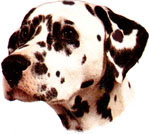 Health Issues
Health Issues

 Perhaps the most well-known Dalmatian Health problem is deafness.
Perhaps the most well-known Dalmatian Health problem is deafness.Approximately 8% of all Dalmatians are completely deaf (bilaterally deaf);another 22% is deaf in one ear (unilaterally deaf or unilaterally hearing). There is no cure for congenital deafness; and still no clear understanding of how it is transmitted, it is known that deafness in Dalmatians is directly linked to the extreme piebald gene, the gene responsible for the white coat. Even knowing the primary genes responsible for deafness in many breeds,we are still no closer to finding the cause or the cure.
While it is known what genes carry the deafness, not every dog of every breed with either of those two genes will be deaf. Therefore, there must be other genes at work as well; it is those modifiers that elude researchers.
The only way to reduce the incidence of deafness in any breed so afflicted is through careful, responsible breeding. NO bilaterally deaf dog of any breed should be allowed to reproduce. Owners of unilaterally deaf dogs are strongly encouraged to have those dogs spayed/neutered; and should be urged to remove unilaterally deaf dogs from their breeding line/stock Statistically, if just one parent of a litter is unilaterally deaf (assuming the other parent is bilaterally hearing), the chances of completely deaf puppies DOUBLES! One can imagine the statistics on litters with one completely deaf parent!
There are many methods to test whether a dog can hear or not; some more reliable than others. However there is only one sure-fire way to determine if a puppy/dog is unilaterally or bilaterally hearing -- the BAER/BAEP test. BAER/BAEP stands for Brainstem Auditory Evoked Response (Potential). This test measures the brainwave activity when sound is introduced into an ear. If there is very little or no brainwave activity, that ear is considered deaf.
The Dalmatian is not a dog for everyone; a deaf Dalmatian is much more unsuitable for the average family. Placed improperly, a deaf dog will not get the attention and training he/she needs to overcome this disability. Without that proper training and attention, a deaf dog can become easily startled, which can usually lead to biting. The biggest risk is linked to a startle reflex. That being said, there are many people who make it a point to work with deaf dogs and who understand the particular needs and requirements to own and train a deaf dog. A properly trained and socialized deaf dog can live a long and healthy life.